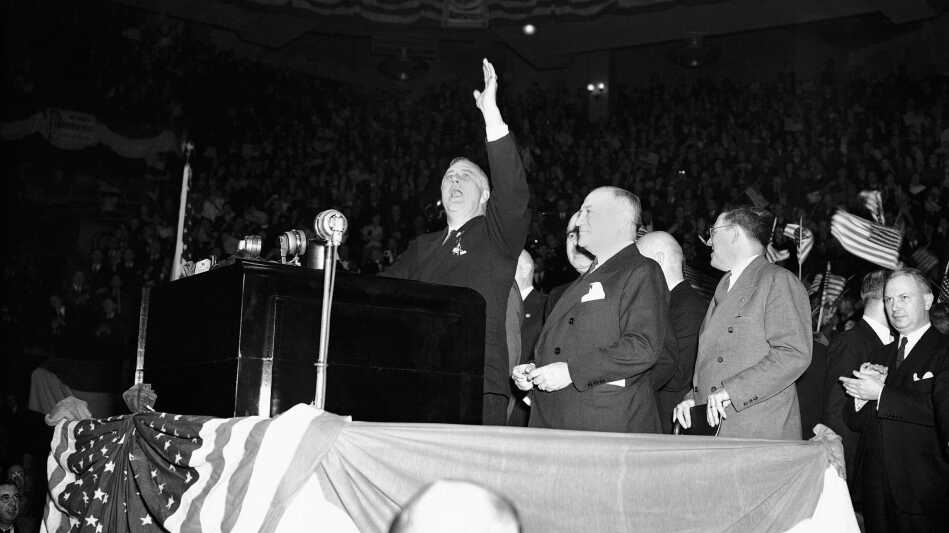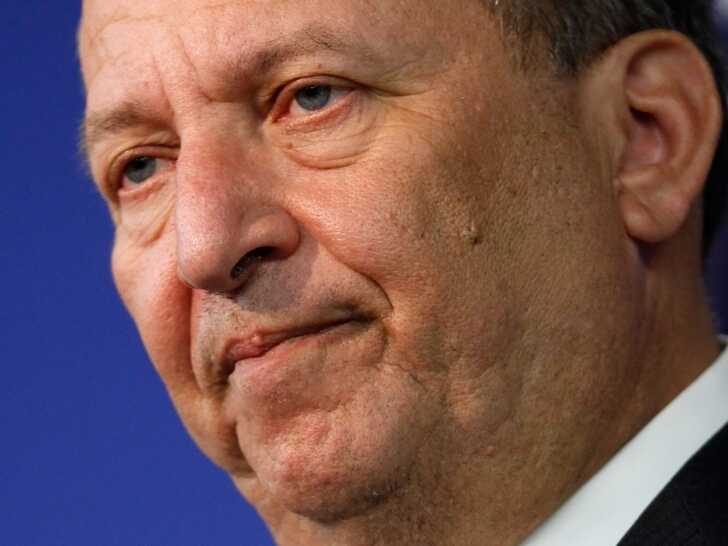What Was The Roosevelt Recession

President Franklin D. Roosevelt drummed up populist back up in one of his last campaign speeches at Madison Square Garden in New York, on Oct. 31, 1936. But later he was re-elected, Roosevelt slashed regime spending. Associated Press hide caption
toggle caption
Associated Press

President Franklin D. Roosevelt drummed up populist support in one of his last campaign speeches at Madison Square Garden in New York, on Oct. 31, 1936. But afterwards he was re-elected, Roosevelt slashed government spending.
Associated Printing
Four years into Franklin Roosevelt's commencement presidential term, the worst of the Great Depression seemed behind him. Massive jolts of New Deal spending had stopped the economic slide, and the unemployment rate was cut from 22 per centum to less than 10 pct.
"People felt that at that place was momentum," U.S. Senate historian Donald Ritchie tells Guy Raz, host of weekends on All Things Considered. "Finally, there was the light at the end of the tunnel."
Then Roosevelt, on the advice of his bourgeois Treasury Secretary Henry Morgenthau, decided to tackle the country's exploding deficits. Over two years, FDR slashed regime spending 17 percentage.
"All of a sudden," Ritchie says, "after unemployment had been going steadily down, unemployment shot up, the economy stagnated, the stock market crashed once again. And now it seemed we'd come out of the Hoover Depression to go into the Roosevelt recession."
Similar decisions Roosevelt made about spending and austerity are being discussed at the White House right at present. In the long term, both political parties say they agree that austerity is a practiced affair. But what about in the short term, while unemployment remains high?
Could thrift slow economic recovery?
'More Stimulus Now'
Economists disagree almost what caused the 1937 recession.
Unemployment jumped 3 percent the year later FDR cut spending. At the same fourth dimension, the Federal Reserve built its reserves, which meant banks had less to lend. And the payroll taxation had just been introduced.
Merely some, including Bruce Bartlett, who held senior policy positions under Presidents Reagan and George H.W. Bush, fright major budget cuts of the size proposed by President Obama — $4 trillion over 10 years — could exist dangerous to curt-term recovery.

Larry Summers, formerly i of President Obama's top economic directorate, says turning too quickly to thrift could be disastrous for the economy. Chip Somodevilla/Getty Images hide caption
toggle caption
Bit Somodevilla/Getty Images
Former Treasury Secretary Larry Summers is also worried.
"Rushing to deficit reduction was Roosevelt'due south fault in 1937, and that would exist a serious mistake today," he tells Raz.
He points out that current upkeep negotiations are different from those in 1937. Proposals under consideration today would spread cuts over 10 years, instead of FDR'south two.
But Summers says it may all the same exist also soon for austerity.
"The right strategy is stimulus now and more deficit reduction programmed for after the economy has recovered," he says.
Last year'south compromise on a payroll tax interruption, he says, is as an example of what might be politically possible, given the spending impasse between Democrats and Republicans. Summers calls for lengthening that payroll tax cutting, spending more on infrastructure and extending unemployment benefits.
"We say that in a technical sense the recession is over," he says. "That ways the economic system is growing. Merely when you walk through the Grand Canyon, you're going uphill long before you get back to bounding main level. And I recollect we've got several years before this economy is back to normal levels of employment."
What Economists Miss
In the years leading up the recession, announcer Gillian Tett was one of the first people to warn that something new and dangerous was happening in the global credit market.
She was named British Journalist of the Yr in 2009. Today she's the U.South. managing editor for the Financial Times. And she has a doctorate not in finance, but in anthropology. And that's ane reason she says economists like Summers don't have all the answers.
"Because right at present, issues like social cohesion are crucial for understanding what'southward going on," she says. "America is not a country which has a very potent sense of resource constraint. Information technology was created by pioneers who came hither believing that at that place would always be more resources. And at that place'southward been such a focus on growing the economical pie that people haven't really stopped to ask, 'How do yous divide up that economic pie?' "
European investors and policymakers, by contrast, can't wrap their heads around the U.South. debt deadlock, she says.
"They find information technology quite unbelievable that a country would, in a sense, choose to walk into a debt crunch, given that people in Europe are having a debt crunch imposed on them without pick. In that location is a sense of incomprehension that the politicians tin can't sit around the tabular array and come up with some sort of proactive programme."
Summers' forecast of several more than years without normal levels of employment is sobering, she adds.
"It makes a question of social cohesion and whether America has a fashion of allocating hurting even more pertinent," Tett says.
Social divisions are widening in America, she says. Income inequality is growing. Tett warns that may create even more tension going forward.
"And I love America," she says. "I call up it'south got so much to be proud of. I simply really hope that information technology finds a way to tackle these problems."
What Was The Roosevelt Recession,
Source: https://www.npr.org/2011/07/16/138185648/when-a-turn-toward-austerity-turned-to-disaster
Posted by: christoffersothemnioncy64.blogspot.com


0 Response to "What Was The Roosevelt Recession"
Post a Comment